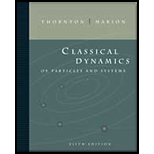
The generalized coordinates and description about the rolling disk.
Answer to Problem 7.1P
The generalized coordinates and description about the rolling disk are given.
Explanation of Solution
In order to describe the rolling of disk without slipping, four generalized coordinates are required. They are – x coordinate, y coordinate, angle

Equation of motion for the rolling disk is,
Here,
These equations are not integrable. Moreover, all the generalized coordinates cannot be combined into a single equation. Hence, the constraints are nonholonomic.
Conclusion:
Therefore, generalized coordinates and description about the rolling disk are given.
Want to see more full solutions like this?
Chapter 7 Solutions
Classical Dynamics of Particles and Systems
- For any arbitrary vectors u, v and w, prove thatarrow_forwardNote: Because the arguments of the trigonometric functions are unitless in this question, your calculator must be in radian mode if you use it to evaluate any trigonometric functions. When powered up, a disk drive starts at rest and spins up with non-uniform angular acceleration according to the following formula: =asin(bt) where a = 708 radians/s2 and b = 1.74 s-1. This lasts for the first 1.81 seconds, after which the drive does not accelerate. How many meters of disk surface have passed underneath the head in 0.79 seconds?arrow_forward(The complete question is in the picture) Three identical point masses are arranged to an equilateral triangle as shown. Let point P be the center of the triangle formed by the masses, Q be located at one vertex of the triangle, and S be the midpoint of the line joining two of the three masses. Consider thefollowing orientations where the axis of rotation of the triangle can be located:I. out of the page, passing through PII. along the line `III. out of the page, passing through QIV. out of the page, passing through SHow would you rank them in terms of increasing moment of inertia? A. II, III, IV, IB. II, I, III, IVC. II, III, I, IVD. II, I, IV, IIIarrow_forward
- Consider a vector Q that rotates at angular frequency ω about some fixed axis of rotation (~ω).Further, Q is at a fixed angle α relative to that axis. Show that the time rate of change of Q is given byarrow_forwardIf a particle be describing an ellipse about a centre of force in the centre, show that the sum of the reciprocates of its angular velocities about foci is constant.arrow_forward
 Classical Dynamics of Particles and SystemsPhysicsISBN:9780534408961Author:Stephen T. Thornton, Jerry B. MarionPublisher:Cengage Learning
Classical Dynamics of Particles and SystemsPhysicsISBN:9780534408961Author:Stephen T. Thornton, Jerry B. MarionPublisher:Cengage Learning
